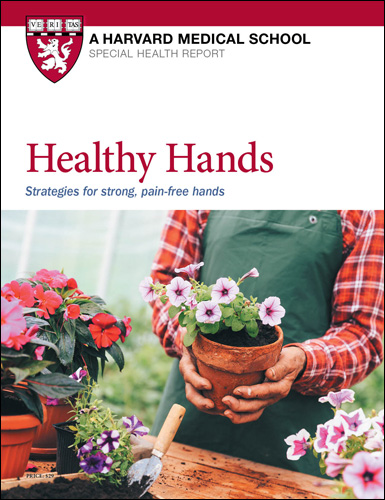Get a helping hand for pain
Hand osteoarthritis can be painful, but there are strategies to help you manage it and maintain function.

Your hands work hard from the moment they pick up your toothbrush in the morning to the time they pull your covers up at night. If you've got osteoarthritis in the joints of your hands, all those daily tasks can become more of a challenge.
Osteoarthritis is a common condition that occurs when the cartilage between the bones begins to break down. Cartilage acts as a smooth padding, cushioning the bones and allowing the joint to move freely. When it deteriorates, the bones may start to rub together, triggering inflammation that causes pain and stiffness.
Osteoarthritis of the hand is not only a common cause of hand pain, but occurs more often in women than in men, says Dr. Barry Simmons, associate professor of orthopedic surgery at Harvard Medical School. The condition also has a strong genetic component. While osteoarthritis in the hands can be debilitating, there are a number of strategies you can use to manage it, he says.
Joints most affected by osteoarthritis
Osteoarthritis affects four types of joints in the human hand, but most often strikes those closest to the fingertips. Illustration by Scott Leighton |
The origins of stiffness and pain
Osteoarthritis affecting the hands most commonly occurs in the joints closest to the fingertip, known as the distal interphalangeal joints, says Dr. Simmons. People might notice that the end of their finger looks a little knobby or has started to bend toward the pinky finger. The joint may also feel stiff when you move it.
Other hand joints commonly affected include the proximal interphalangeal joints, which are the joints in the middle of the fingers, and the joint at the base of the thumb, known as the first carpometacarpal joint. Less commonly, the problem occurs in the joint where the finger meets the hand, called the metacarpophalangeal joint, says Dr. Simmons.
While many people are most affected by the pain and stiffness caused by osteoarthritis, some people are also bothered by the physical changes that osteoarthritis may cause. These include the appearance of cysts or bony nodules on the fingers, crooked finger joints, and swelling.
Treating osteoarthritis
The primary goals of osteoarthritis treatment are to relieve pain and improve function, says Dr. Simmons. This may require a combination of approaches, such as the following:
Splinting. Your doctor may recommend immobilizing the joint with a splint. "Splinting is solely for pain relief, but you'll only have pain relief when the splint is on," says Dr. Simmons. Splinting will not correct a joint deformity. The finger will revert back to its former position when the splint is removed.
Ice and heat. Another strategy to soothe sore joints is to use heat or ice. Icing a joint may reduce inflammation and using methods to warm up a joint, such as soaking in warm water, might help ease stiffness.
Medication. Some people effectively manage mild to moderate osteoarthritis pain using topical pain relievers, which come in many forms, including creams, patches, and gels. They are available in both prescription and over-the-counter formulations.
Oral pain medications, particularly nonsteroidal anti-inflammatory drugs (NSAIDs) such as ibuprofen (Advil, Motrin) and naproxen (Aleve), can help ease osteoarthritis pain and reduce inflammation. But they will not cure the underlying problem, says Dr. Simmons.
Injected medications, called corticosteroids, may grant temporary relief. However, many doctors use them sparingly because they may worsen osteoarthritis in the long run, by hastening damage to the bone and cartilage.
Exercise. Building strength and endurance through regular exercise can help reduce hand pain and improve function. Working with a specialist trained in hand therapy can ensure that your efforts are on the right track. A hand therapist will typically help you set goals and design an exercise plan, says Dr. Simmons.
Lifestyle adjustments. A hand therapist may also advise you on ways to change your everyday routines to minimize pain—for instance, by structuring activities to avoid pain flare-ups, or by using tools and assistive devices to ease certain tasks, such as opening jars.
Surgery. Surgery is typically saved as a last resort after other strategies to manage arthritis pain have failed. Options include joint replacement (arthroplasty), which involves removing damaged bone and tissues and replacing them with a prosthetic joint, and joint fusion (arthrodesis) to permanently immobilize the joint.
Image: © Suze777/Getty Images
About the Author

Maureen Salamon, Executive Editor, Harvard Women's Health Watch
Disclaimer:
As a service to our readers, Harvard Health Publishing provides access to our library of archived content. Please note the date of last review or update on all articles.
No content on this site, regardless of date, should ever be used as a substitute for direct medical advice from your doctor or other qualified clinician.

















